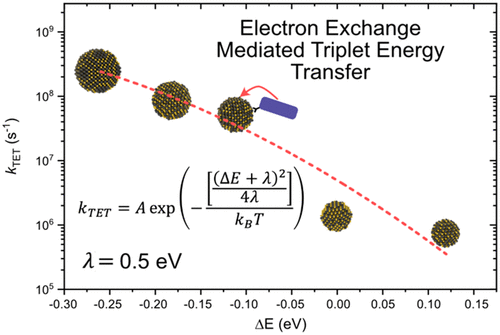Our official English website, www.x-mol.net, welcomes your feedback! (Note: you will need to create a separate account there.)
Direct vs Delayed Triplet Energy Transfer from Organic Semiconductors to Quantum Dots and Implications for Luminescent Harvesting of Triplet Excitons.
ACS Nano ( IF 17.1 ) Pub Date : 2020-03-18 , DOI: 10.1021/acsnano.9b09339 Victor Gray 1, 2 , Jesse R Allardice 1 , Zhilong Zhang 1 , Simon Dowland 1 , James Xiao 1 , Anthony J Petty 3 , John E Anthony 3 , Neil C Greenham 1 , Akshay Rao 1
ACS Nano ( IF 17.1 ) Pub Date : 2020-03-18 , DOI: 10.1021/acsnano.9b09339 Victor Gray 1, 2 , Jesse R Allardice 1 , Zhilong Zhang 1 , Simon Dowland 1 , James Xiao 1 , Anthony J Petty 3 , John E Anthony 3 , Neil C Greenham 1 , Akshay Rao 1
Affiliation

|
Hybrid inorganic-organic materials such as quantum dots (QDs) coupled with organic semiconductors have a wide range of optoelectronic applications, taking advantage of the respective materials' strengths. A key area of investigation in such systems is the transfer of triplet exciton states to and from QDs, which has potential applications in the luminescent harvesting of triplet excitons generated by singlet fission, in photocatalysis and photochemical upconversion. While the transfer of energy from QDs to the triplet state of organic semiconductors has been intensely studied in recent years, the mechanism and materials parameters controlling the reverse process, triplet transfer to QDs, have not been well investigated. Here, through a combination of steady-state and time-resolved optical spectroscopy we study the mechanism and energetic dependence of triplet energy transfer from an organic ligand (TIPS-tetracene carboxylic acid) to PbS QDs. Over an energetic range spanning from exothermic (-0.3 eV) to endothermic (+0.1 eV) triplet energy transfer we find that the triplet energy transfer to the QD occurs through a single step process with a clear energy dependence that is consistent with an electron exchange mechanism as described by Marcus-Hush theory. In contrast, the reverse process, energy transfer from the QD to the triplet state of the ligand, does not show any energy dependence in the studied energy range; interestingly, a delayed formation of the triplet state occurs relative to the quantum dots' decay. Based on the energetic dependence of triplet energy transfer we also suggest design criteria for future materials systems where triplet excitons from organic semiconductors are harvested via QDs, for instance in light emitting structures or the harvesting of triplet excitons generated via singlet fission.
中文翻译:

从有机半导体到量子点的三重态能量的直接或延迟转移,以及三重态激子的发光收获的含义。
利用有机材料的优势,诸如有机半导体等量子点(QDs)的混合无机有机材料具有广泛的光电应用。这种系统研究的一个关键领域是三重态激子态与量子点之间的转移,这在光催化裂变产生的三重态激子的发光收获,光催化和光化学上转换方面具有潜在的应用前景。尽管近年来已经对从QD到有机半导体三重态的能量转移进行了深入研究,但控制反向过程,向QD的三重态转移的机理和材料参数尚未得到很好的研究。这里,通过结合稳态和时间分辨光谱,我们研究了三重态能量从有机配体(TIPS-并四苯甲酸)转移到PbS量子点的机理和能量依赖性。在从放热(-0.3 eV)到吸热(+0.1 eV)的高能范围内,我们发现将三重态能量转移到QD的过程是通过一步法完成的,该过程具有明显的能量依赖性,与电子交换相一致如Marcus-Hush理论所述。相反,逆过程,即从QD到配体的三重态的能量转移,在所研究的能量范围内未显示任何能量依赖性。有趣的是,相对于量子点的衰变,三重态的延迟形成发生了。
更新日期:2020-03-17
中文翻译:

从有机半导体到量子点的三重态能量的直接或延迟转移,以及三重态激子的发光收获的含义。
利用有机材料的优势,诸如有机半导体等量子点(QDs)的混合无机有机材料具有广泛的光电应用。这种系统研究的一个关键领域是三重态激子态与量子点之间的转移,这在光催化裂变产生的三重态激子的发光收获,光催化和光化学上转换方面具有潜在的应用前景。尽管近年来已经对从QD到有机半导体三重态的能量转移进行了深入研究,但控制反向过程,向QD的三重态转移的机理和材料参数尚未得到很好的研究。这里,通过结合稳态和时间分辨光谱,我们研究了三重态能量从有机配体(TIPS-并四苯甲酸)转移到PbS量子点的机理和能量依赖性。在从放热(-0.3 eV)到吸热(+0.1 eV)的高能范围内,我们发现将三重态能量转移到QD的过程是通过一步法完成的,该过程具有明显的能量依赖性,与电子交换相一致如Marcus-Hush理论所述。相反,逆过程,即从QD到配体的三重态的能量转移,在所研究的能量范围内未显示任何能量依赖性。有趣的是,相对于量子点的衰变,三重态的延迟形成发生了。


























 京公网安备 11010802027423号
京公网安备 11010802027423号